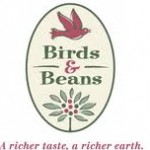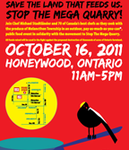Archive for October, 2011
I’ve been noticing the birds this year, migrating south. It’s a beautiful site to behold if you don’t think about what it means: “See ya, suckas, we’s outta here!”
They are not so dumb, those birds. They are off to warmer climes in South and Central America, where hopefully there is a forest waiting for them, or at least some agroforestry that has not completely destroyed their winter habitat.
Yes, bird habitat is decreasing and, strange as it may sound, your cup of coffee has a lot to do with it.
As you already know, the clear cutting of tropical rain forests is destroying traditional bird sanctuaries, not to mention entire ecosystems. As a direct result, bird populations are decreasing. And by birds, I mean local and migratory birds. And by migratory, I mean our birds, or the ones we like to think of as ours – the ones we say good-bye to each fall and welcome back each spring.
Some of these birds return to their forested nesting ground only to find wide-open field. With nowhere to nest, they perish. Some, however, are able to seek refuge in shade coffee farms – farms that use a natural tree shade canopy to grow its crop.
However, after chatting with Madeleine Pengelley, owner of certified Bird Friendly® Birds and Beans roastery and café, I understand that not all shade coffee farms are created equally.
Coffee is naturally a shade-loving plant. Although originally imported from Africa, coffee can grow wild in South and Central American forests. It has also been traditionally grown for centuries in small-scale, rustic shade farms that make use of the natural forest canopy, usually old growth or secondary forest, to produce slower ripening and richer tasting coffee.
In the 1960s, in the name of progress and higher yield, a strain of coffee was developed that was able to tolerate the bright sun. Farmers cleared their land, sold their lumber, and planted the new coffee.
Yes, yield went up and so did sales, but bean quality and taste went down — as did local water and soil quality, animal and bird populations, and any extra income farmers might have earned from wood or fruit products provided by the former forest.*
As a result, shade coffee farms began to emerge as a new trend to counteract the negative effects of sun-grown coffee. These farms use a number of assorted shade trees and other plants to create a canopy that enables the type of symbiotic ecosystem that supports life and sustainable coffee cultivation.
Shade farming works with the environment, not against it; as a result, it doesn’t require the chemical inputs like fertilizers, pesticides, fungicides and herbicides that clear cut coffee farms have come to rely on.
Shade coffee farming is an organic and sustainable model that offers protection to endangered birds and wildlife, not to mention a viable livelihood for local farmers and unpolluted water to all communities downstream.
Unfortunately, economic realities being what they are, even well intentioned shade farmers are at times forced to chop down a few trees. The income from the lumber can be the difference between a child going to school that year or not. And the next year, it can be the same story.
I find no fault with the farmers who are simply doing what is necessary to get by, but if we could make the living tree more valuable to a farmer than the lumber it produces, then we’d be getting somewhere, says Madeleine.
Working towards this model is the Smithsonian’s Migratory Bird Center’s Bird Friendly® coffee certification program, which encourages coffee farmers to follow specific shade management practices. The various criteria include canopy height, foliage cover, tree diversity, leaf litter, and so on, all of which guarantee a minimum shade of 40% and an organic, sustainable and fair trade product.
Coffee ain’t local food where I live. But when you can’t go local, you go organic, sustainable, fair trade and, now, Bird Friendly®. This is not yet another food certification for you to contend with, this makes a lot of sense and does affect you in your own backyard. They are your birds too.
We do have the ability to change this particular problem because it is motivated by our own consumption habits.
Take a minute to sip on that.
* Read more about food sovereignty and agroforestry in Wayne Roberts’ The No-Nonsense Guide to World Food, 2008, ISBN 978-1-897071-44-1.
This Sunday, October 16, is World Food Day. As decreed by the UN’s Food and Agriculture Organization, it is the official day to encourage agricultural food production and stimulate farming efforts, as well as several other food security issues.
If you’re looking to celebrate local bounty and defend your right to healthy, local food, this Sunday is your day.
And lucky you, if you’re in Southern Ontario, this weekend is Foodstock.
Even the Foodstock poster recalls that other ‘stock that changed so much, which took place back in 1969 in an upstate New York farmer’s field. Remember that? Neither do I. This time, the little birdy is perched on a saucepan handle. Nice.
The Foodstock deets
If you haven’t heard, Foodstock is a pay-what-you-can, outdoor, food and music event in Melancthon County. It is the baby of activist chef Michael Stadtländer, who has invited some 100 top chefs from across Canada to prepare locally produced treats just for you. And it gets better.
Foodstock is a fundraiser to support of the movement to Stop the Mega Quarry. All funds go to stop the mega quarry application by the Highland Companies to create a limestone quarry that would cover over 2300 acres of prime agricultural land and dig into pristine aquifers next to the Niagara Escarpment.
Sunday’s event is open to the public and is pay-what-you-can, though the suggested price is $10 – which is a steal if you consider the caliber of chefs who will be there — all the gros fromages from Toronto’s resto scene and beyond, including Jamie Kennedy, Pizzeria Libretto, Oyster Boy, Café Belong and Enoteca Sociale. Ethical suppliers such as Hooked, Cumbrae’s and Choco Sol have also offered support.
By bringing local food producers and consumers together, Foodstock aims to highlight the connection between eaters and farmers, and encourage those who love local food to stand up and voice their opposition to a project whose opponents fear will destroy the region’s farmland and way of life.
The Highland Companies is owned by a Boston-based hedge fund. According to the Toronto Star, the company assembled farmland north of Organgeville to grow potatoes, and then made their application to develop one the biggest rock quarries in Canada—1 million tonnes of limestone from fertile potato fields. We need limestone, yes. But do we need this limestone? It sets an odd precedence to value pavement over food.
When: Sunday Oct 16, 11 a.m. to 5 p.m.
Where: Outdoors, on the Honeywood-area farm of Diane and Bill French, who own remaining farmland that has not sold to the Highland Companies
Transportation: http://nomegaquarry.ca/events/foodstock/
Cost: PWYC, suggested price $10. Pay in advance or at the gate.
What to bring: dress for the outdoors and, if you can, bring your own plates and cutlery to cut down on waste
Despite the rain and chilly weather today, the fifth Picnic at the Brickworks was a feast of flavours that warmed the bellies of all who attended the open air space.
As a first-timer to this annual event, I didn’t know what to expect. I secretly feared foodie elitism might set the tone, but it couldn’t have been farther from the truth. It was a farm friendly, food lovin’ crowd who were happy to mix and enjoy some friendly conversation while sampling some of the tastiest dishes our region has to offer.
The food was fantastic. Seasonal harvests from throughout Southern Ontario’s culinary regions prepared by local chefs committed to sourcing their food from small scale, sustainable, local farms and suppliers.
It would be impossible for every delicious item from every table to be the ultimate winner, but I had the pleasure of enjoying a truly sublime locally sourced squab and bacon cassoulet with pistachio crumble from Auberge du Pommier, and from Canoe, Cumbrae Farms beef tartare with a pine jelly that took it up just the right notch.
Thank you to Evergreen and Slow Food Toronto for making high-end fare a little more user friendly.


